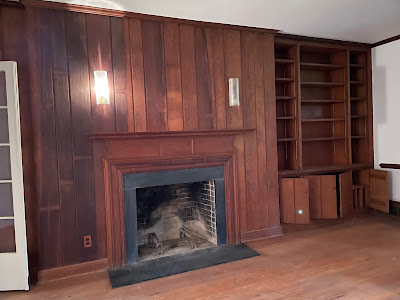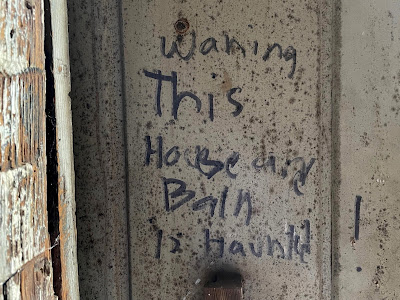An open house at the White Gardens reveals how much work a resident curator would have to take on
 |
| The foyer in the White House. |
Potential resident curators and curious neighbors got a chance to look inside the house at the Margaret White Gardens at an open house on Aug. 7.
The Park Authority is seeking a resident curator to fix up the house. The curator would pay for the needed repairs and maintenance while living in the house rent-free. The lease term would be about 20 years.
 |
| The huge porch at the rear of the house offers views of the gardens. |
The former owner, Margaret White, deeded the property to the Park Authority in 1999 to save the horticultural treasures from development. It’s located in the Falls Church area of Mason District.
According to her son, Doug White, she would not have approved of a resident curator living in the house. She was most concerned about the plantings and didn’t care if the house was bulldozed, he said. If the house was to be preserved, she wanted it to be converted to an educational center focusing on horticulture.
Related story: Margaret White wouldn’t have wanted a ‘resident curator’ for the park that bears her name, her son says
Margaret and her husband John built the house in 1939. There’s a barn on the property dating from around 1876, which could also become the responsibility of the resident curator, depending on the agreement with the Park Authority, said Stephanie Langton, manager of the Resident Curator Program.
 |
| The kitchen |
The 2,340-square foot house has four bedrooms, three bathrooms, a kitchen, a living room, dining room, storage room in an attic space, and a 956-square foot wraparound enclosed porch. Langton pointed out a few noteworthy features, including the U-shaped staircase and decorative arches over some of the windows.
 |
| The living room features a fireplace and built-in shelves. |
The entire house would become the resident curator’s dwelling place. The curator would be responsible for maintaining the house only and the area immediately around it, which is less than a quarter-acre, said Langton. Green Spring Gardens staff would be responsible for taking care of the horticultural resources, and due to budget limitations, would rely on volunteers to carry out much of the work.
 |
| A greenhouse once stood just outside the kitchen door. |
According to Langton, the resident curator program is in line with the mission in the Master Plan for the Margaret White Gardens, which “allows the house to be rented for residential use as long as any revenue produced is used for park purposes.”
 |
| There’s a swing and basketball hoop in the barn. |
“The program entails a public benefit,” she said, so, at the least, there would be a requirement that there be an open house for the public once a year. The rest of the property would continue to be open to the public.
An evaluation of the house prepared for the Park Authority by Wiss, Janney, Elstner Associates Inc. in 2017 includes an extensive list of the work that needs to be done to rehabilitate the house and estimates the cost at $568,800. It would take another $292,600 to restore the barn.
 |
| One of the three bathrooms in the house. |
According to the report, the top priority should be fixing the roof to prevent water infiltration and further deterioration. Among the other recommendations:
- Replace missing or damaged gutters and downspouts.
- Remove built-up debris against the basement windows, and ensure the drains in window wells are working properly.
- Replace severely cracked bricks.
- Remove the paint on the wooden window frames, clean the wood, replace deteriorated glazing putty, and repaint the wood.
- Repair cracked or missing plaster.
- Clean, repair, and repaint all wood and metal cabinets, staircases, doors, and ornamental wood throughout the house.
- Replace cracked or missing linoleum tiles in the kitchen and bathrooms.
 |
| The house has been boarded up to prevent intruders. |
The Park Authority carried out some basic repairs more recently, including removing the wallpaper, installing a new HVAC system, fixing the well, and mold mitigation, Langton said. Its next job is repairing the septic tank.
 |
| A new HVAC system in the basement. |
Curators are responsible for the costs of all materials, equipment rentals, and contractors. The curator’s sweat equity would be credited towards the curator’s overall financial investment.
At least 25 people came to the open house on Saturday, Langton said, and two of them expressed an interest in applying to be the resident curator. The application has not been posted online but should be available soon.
 |
| Grafitti in the barn. |
There will be a 60-calendar day application period, followed by an evaluation process which would take at least three months, including a 30-day public comment period. Once a curator is selected, the leasing process will take at least six to nine months.

Almost $600,000 just to rehab the house? Who is going to spend that money when they dont even own it? Am I missing something?
I was wondering the exact same thing. Is this house really historically significant or architecturally elegant? I find that hard to believe. Not every old building (this one isn't even 100 years old) is historically significant.
The home should be converted into a park-appropriate structure or torn down.
Hypothetically, you're getting over $700K in free rent ($35,400/year x 20-year lease) to offset the cost. If you are a contractor or otherwise can do some or all of this work yourself, you could potentially cut the $600K in half or more if you just have to pay for materials. And you might be able to take a tax deduction for the cost of the materials. It still seems like a bad deal — if you're going to lock yourself into living somewhere for 20 years, and have the cash needed to buy this much in materials — you'd be better off buying. But maybe the math works for someone out there.